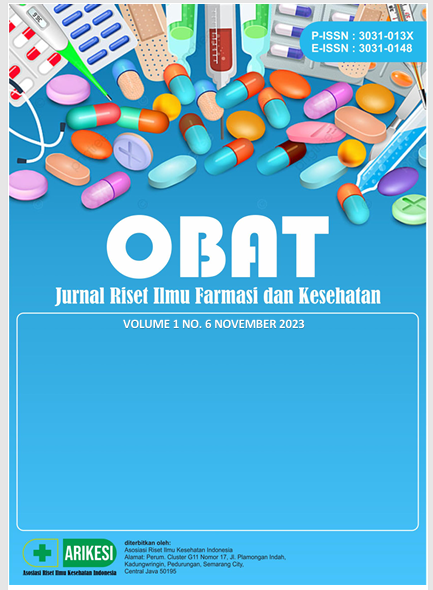Effects Of Psidium Guajava Crude Leaf Methanol-Extract On Lowering Blood Sugar Levels In Rat
DOI:
https://doi.org/10.61132/obat.v1i6.268Keywords:
Blood Sugar Level, Diabetes, Guava LeafAbstract
Blood sugar levels, or blood glucose levels, are crucial for overall health and are regulated by the pancreas through insulin. Normal blood sugar levels range between 70-99 mg/dL when fasting and up to 140 mg/dL two hours after eating. Abnormal blood sugar levels can suggest a variety of health issues, including hypoglycemia (low blood sugar levels caused by excess insulin, certain drugs, or illnesses such as diabetes) and hyperglycemia (high blood sugar levels associated with diabetes). Regular blood sugar monitoring is necessary, especially for diabetics. Guava, a tropical fruit, includes a variety of phytochemicals that have been linked to pharmacological benefits such as antibacterial capabilities. This research uses an extraction process involving solid-liquid extraction or maceration, with methanol being the optimal solvent. The extract yields 9.51%. Wistar rats are used to investigate its antidiabetic efficacy. The rats are divided into three groups: positive control, negative control, and extract treatment. Diabetes is induced by subcutaneous injection of Alloxan, followed by oral administration of the methanol extract. Blood glucose levels are assessed after fasting for 6-8 hours. The extract from dried Guava leaf powder yields a concentrated extract with a 9.51% yield. In vivo assessments showed a significant reduction in blood glucose levels in rats treated with guava leaf extract, suggesting potential anti-hyperglycemic effects. The phenolic compounds in guava leaves contribute to antioxidant and anti-hyperglycemic effects. The study highlights the potential therapeutic effects of guava mint leaves and their extract components for diabetes management and antioxidant health benefits.
Downloads
References
Aly, S. H., Eldahshan, O. A., Al-Rashood, S. T., Binjubair, F. A., El Hassab, M. A., Eldehna, W. M., Dall’Acqua, S., & Zengin, G. (2022). Chemical Constituents, Antioxidant, and Enzyme Inhibitory Activities Supported by In-Silico Study of n-Hexane Extract and Essential Oil of Guava Leaves. Molecules, 27(24). https://doi.org/10.3390/molecules27248979
Bagri, P., Ali, M., Aeri, V., & Bhowmik, M. (2016). Isolation and antidiabetic activity of new lanostenoids from the leaves of Psidium guajava L. International Journal of Pharmacy and Pharmaceutical Sciences, 8(9), 14–18. https://doi.org/10.22159/ijpps.2016v8i9.10425
Díaz-de-Cerio, E., Rodríguez-Nogales, A., Algieri, F., Romero, M., Verardo, V., Segura-Carretero, A., Duarte, J., & Galvez, J. (2017). The hypoglycemic effects of guava leaf (Psidium guajava L.) extract are associated with improving endothelial dysfunction in mice with diet-induced obesity. Food Research International, 96, 64–71. https://doi.org/10.1016/j.foodres.2017.03.019
Díaz-De-Cerio, E., Verardo, V., Gómez-Caravaca, A. M., Fernández-Gutiérrez, A., & Segura-Carretero, A. (2016). Exploratory characterization of phenolic compounds with demonstrated anti-diabetic activity in guava leaves at different Oxidation States. International Journal of Molecular Sciences, 17(5). https://doi.org/10.3390/ijms17050699
Huang, Z., Luo, Y., Xia, X., Wu, A., & Wu, Z. (2021). Bioaccessibility, safety, and antidiabetic effect of phenolic-rich extract from fermented Psidium guajava Linn. leaves. Journal of Functional Foods, 86. https://doi.org/10.1016/j.jff.2021.104723
Lin, C. F., Kuo, Y. T., Chen, T. Y., & Chien, C. T. (2016). Quercetin-rich guava (Psidium guajava) juice in combination with trehalose reduces autophagy, apoptosis and pyroptosis formation in the kidney and pancreas of type II diabetic rats. Molecules, 21(3). https://doi.org/10.3390/molecules21030334
Luo, Y., Peng, B., Liu, Y., Wu, Y., & Wu, Z. (2018). Ultrasound extraction of polysaccharides from guava leaves and their antioxidant and antiglycation activity. Process Biochemistry, 73, 228–234. https://doi.org/10.1016/j.procbio.2018.08.003
Luo, Y., Peng, B., Wei, W., Tian, X., & Wu, Z. (2019). Antioxidant and anti-diabetic activities of polysaccharides from guava leaves. Molecules, 24(7). https://doi.org/10.3390/molecules24071343
Mazumdar, S., Akter, R., & Talukder, D. (2015). Antidiabetic and antidiarrhoeal effects on ethanolic extract of Psidium guajava ( L .) Bat. leaves in Wister rats Asian Pacific Journal of Tropical Biomedicine. In Asian Pac J Trop Biomed (Vol. 5, Issue 1). www.elsevier.com/locate/apjtb
Proboningsih, J., Joeliantina, A., Novitasari, A., & Purnamawati, D. (2020). Complementary treatment to reduce blood sugar levels of type 2 diabetes mellitus patients. International Journal of Public Health Science, 9(3), 267–271. https://doi.org/10.11591/ijphs.v9i3.20434
Rajput, R., & Kumar, K. (2021). Protective effect of ethanolic extract of guava leaves (Psidium guajava L.) in alloxan-induced diabetic mice. Materials Today: Proceedings, 47, 437–439. https://doi.org/10.1016/j.matpr.2021.04.617
Russell, W. R., Baka, A., Björck, I., Delzenne, N., Gao, D., Griffiths, H. R., Hadjilucas, E., Juvonen, K., Lahtinen, S., Lansink, M., Loon, L. Van, Mykkänen, H., östman, E., Riccardi, G., Vinoy, S., & Weickert, M. O. (2016). Impact of Diet Composition on Blood Glucose Regulation. Critical Reviews in Food Science and Nutrition, 56(4), 541–590. https://doi.org/10.1080/10408398.2013.792772
Shabbir, H., Kausar, T., Noreen, S., Rehman, H. U., Hussain, A., Huang, Q., Gani, A., Su, S., & Nawaz, A. (2020). In vivo screening and antidiabetic potential of polyphenol extracts from guava pulp, seeds and leaves. Animals, 10(9), 1–14. https://doi.org/10.3390/ani10091714
Tella, T., Masola, B., & Mukaratirwa, S. (2022). Anti-diabetic potential of Psidium guajava leaf in streptozotocin induced diabetic rats. Phytomedicine Plus, 2(2). https://doi.org/10.1016/j.phyplu.2022.100254
Zhu, X., Ouyang, W., Lan, Y., Xiao, H., Tang, L., Liu, G., Feng, K., Zhang, L., Song, M., & Cao, Y. (2020). Anti-hyperglycemic and liver protective effects of flavonoids from Psidium guajava L. (guava) leaf in diabetic mice. Food Bioscience, 35. https://doi.org/10.1016/j.fbio.2020.100574
Downloads
Published
How to Cite
Issue
Section
License
Copyright (c) 2023 OBAT: Jurnal Riset Ilmu Farmasi dan Kesehatan

This work is licensed under a Creative Commons Attribution-ShareAlike 4.0 International License.





